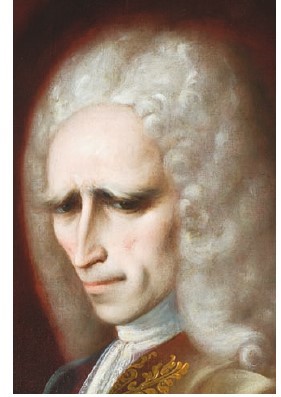 1. In the fall of 1710 the very wealthy Don Pedro Sanchez de Tagle, soon to be created the Second Marquis of Altamira, was in a celebratory mood. The Mexican virrey he detested was finally being replaced with a man much more sympathetic to the Tagle family. Don Pedro celebrated the departure of the Duke of Alburquerque and the arrival the Duke of Linares by buying the office of tallador mayor (chief die sinker) of the Mexico City mint. Don Pedro bought the office in perpetuity and with the right to bequeath it to his heirs. [1a]
1. In the fall of 1710 the very wealthy Don Pedro Sanchez de Tagle, soon to be created the Second Marquis of Altamira, was in a celebratory mood. The Mexican virrey he detested was finally being replaced with a man much more sympathetic to the Tagle family. Don Pedro celebrated the departure of the Duke of Alburquerque and the arrival the Duke of Linares by buying the office of tallador mayor (chief die sinker) of the Mexico City mint. Don Pedro bought the office in perpetuity and with the right to bequeath it to his heirs. [1a]
2. Coincident with Don Pedro assuming the office at the beginning of 1711, the dies of the Mexican gold coinage show a dramatic change in the cross side design. The Bourbon shield design of Philip V, mandated by Spain nine years before, could not be modified, but the Box-End cross design that had served for more than a decade (1700-1710) was suddenly discontinued. No serviceable Box-End Cross reverses were retained for even brief use in 1711, suggesting that the changeover possibly had some significance that is lost to us. A puzzling complication (and the main subject of this essay) is the fact that Mexico City replaced the Box-End Cross with not one but two new cross designs in 1711, continuing both new designs into 1712. [1b]
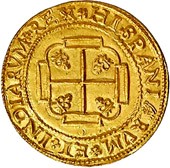 To the left we show a galano (royal) of 1702 illustrating the discontinued Box-End cross. This design was introduced in 1700, replacing the mix of Jeweled Cross and Plain Cross reverses being used at the end of Carlos II’s reign. The Box-end cross design shows a simplification of the 1679-99 designs in the both cross and tressures. Interestingly, it seems the introduction of the Box-End cross design in 1700 had also coincided with the appointment of a new chief die sinker. Following the death of the previous holder of the office, the long-serving Juan de Carbueñas, the new tallador mayor, Don Diego de Carballido, inherited the office and shortly began the Box-end cross issues (1700-1710). Alburquerque’s tenure as virrey from November 1702 to January 1711 also fits roughly with the period of the Box-end coinage. The Box-end cross issues may have been identified with Albuquerque’s controversial regime, which had imprisoned Don Pedro and other members of the Tagle family some years before.
To the left we show a galano (royal) of 1702 illustrating the discontinued Box-End cross. This design was introduced in 1700, replacing the mix of Jeweled Cross and Plain Cross reverses being used at the end of Carlos II’s reign. The Box-end cross design shows a simplification of the 1679-99 designs in the both cross and tressures. Interestingly, it seems the introduction of the Box-End cross design in 1700 had also coincided with the appointment of a new chief die sinker. Following the death of the previous holder of the office, the long-serving Juan de Carbueñas, the new tallador mayor, Don Diego de Carballido, inherited the office and shortly began the Box-end cross issues (1700-1710). Alburquerque’s tenure as virrey from November 1702 to January 1711 also fits roughly with the period of the Box-end coinage. The Box-end cross issues may have been identified with Albuquerque’s controversial regime, which had imprisoned Don Pedro and other members of the Tagle family some years before.
To be clear, we have no document that reveals Don Pedro asking for or ordering changes in the cross designs in 1711. The chronology of the changes is suggestive, but at this point no more than that. Some scholars believe all design changes needed to come from Spain. This conjecture is not substantiated for any Spanish Colonial mint. A powerful chief die sinker, or even working his deputy, probably felt he had the authority to make some changes, at least in designs not ordered by Spain. We cannot say more at the present.
 3. To the left we illustrate one of the new designs of 1711, the Ornate Cross design. The Ornate Cross is generally assumed to be the first new design introduced in 1711, but the evidence for this, as we will see, is not conclusive. The Ornate Cross features a thin plain cross ending in heavy crossbars (the so-called “Cross of Jerusalem”). Ornate tressures with recurved ends and fronds are sandwiched between and sometimes connect its crossbars. The tressures are in a style not seen on other Mexican or Spanish Colonial coinage. Potosi’s reales do use high arcing tressures, usually bracket-shaped when well executed, enclosing the ends of its Jerusalem crosses, but it is clear that Mexico’s Ornate Crosses owe nothing to Potosi. One element of the design does connect with the previous Box-end crosses: the fleurs-de-lis in the angles of the cross show much the same style as 1700-1710 fleurs.
3. To the left we illustrate one of the new designs of 1711, the Ornate Cross design. The Ornate Cross is generally assumed to be the first new design introduced in 1711, but the evidence for this, as we will see, is not conclusive. The Ornate Cross features a thin plain cross ending in heavy crossbars (the so-called “Cross of Jerusalem”). Ornate tressures with recurved ends and fronds are sandwiched between and sometimes connect its crossbars. The tressures are in a style not seen on other Mexican or Spanish Colonial coinage. Potosi’s reales do use high arcing tressures, usually bracket-shaped when well executed, enclosing the ends of its Jerusalem crosses, but it is clear that Mexico’s Ornate Crosses owe nothing to Potosi. One element of the design does connect with the previous Box-end crosses: the fleurs-de-lis in the angles of the cross show much the same style as 1700-1710 fleurs.
If the meagre extant coinage is a reliable guide, most (but not all) of the business strike onzas produced in 1711 used an Ornate Cross reverse [2]. Most, possibly all, of the business strikes in 1712 also used an Ornate Cross reverse [3]. While the Ornate Cross design dominates the regular coinage, we have the curious fact that no galanos (royals) of 1711 or 1712 are known with an Ornate Cross. Prior to the salvages of the 1715 Fleet beginning in the early 1960’s, the Ornate Cross design was apparently unknown to scholars of the Mexican cob coinage. Medina (1919), for example, does not know about Ornate Crosses, nor does Pradeau (1938). Lopez-Chavez in his 1961-64 monographs on these series also makes no mention of this design [4]. But for the 1715 Fleet, it seems, this ephemeral coinage design might have disappeared into history.
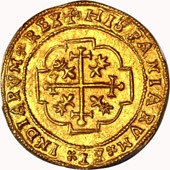 4. Pictured to the left is the reverse of a 1711 galano [5]. Clearly it does not have an Ornate Cross reverse. Instead, it shows the other new design for 1711, the Cross Fleury or Cross with Crosslets. A cross with flaring crosslets is surrounded by symmetric brackets and thin tressures arcing between them. The fleurs in the angles of the cross show a novel, doll-like style. Notice how different this design is from the Ornate Cross. Cross Fleury reverses become the only design used in 1713. The extent of their use in 1711-12 is unclear. Until a few years ago it was thought possible that only galanos were struck with a Cross Fleury reverse in 1711. A circulating eight escudos that surfaced in 2010 has put paid to that theory [6].
4. Pictured to the left is the reverse of a 1711 galano [5]. Clearly it does not have an Ornate Cross reverse. Instead, it shows the other new design for 1711, the Cross Fleury or Cross with Crosslets. A cross with flaring crosslets is surrounded by symmetric brackets and thin tressures arcing between them. The fleurs in the angles of the cross show a novel, doll-like style. Notice how different this design is from the Ornate Cross. Cross Fleury reverses become the only design used in 1713. The extent of their use in 1711-12 is unclear. Until a few years ago it was thought possible that only galanos were struck with a Cross Fleury reverse in 1711. A circulating eight escudos that surfaced in 2010 has put paid to that theory [6].
5. Further remarks on the connection between the Ornate Cross and Cross Fleury issues must await our study of the dies below, but one misconception can be dismissed at once. Some numismatists have suggested that the Cross Fleury design was introduced later in 1711, specifically as a replacement for the “unsatisfactory” Ornate Cross design. The point of this speculation seems to be to avoid accepting concurrent use of Ornate Cross and Cross Fleury dies. The replacement theory has several problems. First we might ask what obvious problem(s) with the Ornate Cross design are supposed to be remedied by the Cross Fleury. No contemporary documents record any dissatisfaction with the new Ornate Cross design.
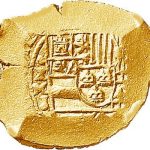 A more conclusive objection to replacement is the fact that we have at least one dated 1712 regular issue onza with an Ornate Cross. If the Ornate cross is condemned and discontinued in 1711, how does it manage to return in the 1712 coinage? Rather than being replaced with Cross Fleury dies in late 1711 and throughout 1712, it is possible that a very large (or all) portion of the 1712 onza mintage bore Ornate Crosses.
A more conclusive objection to replacement is the fact that we have at least one dated 1712 regular issue onza with an Ornate Cross. If the Ornate cross is condemned and discontinued in 1711, how does it manage to return in the 1712 coinage? Rather than being replaced with Cross Fleury dies in late 1711 and throughout 1712, it is possible that a very large (or all) portion of the 1712 onza mintage bore Ornate Crosses.
5. We don’t know why no Ornate Cross dies were used with or prepared for the 1713 coinage. It seems to have been a deliberate decision as no Ornate Cross dies were used in the course of the very busy mintage of 1713 (which repeatedly drafted galano dies into the regular coinage). One suggestion is that no Ornate Cross dies were left over from the mintages of 1711-12 and no new ones could be prepared. Comparing the Ornate and Cross Fleury designs, one is struck by how different their artistic visions are. The organic, gracefully curving, scallop-like tressures of Ornate Cross share nothing with the sharp, right-angled brackets and crosslets of the Cross Fleury. The fleurs in the angles of their cross are also as different as these designs as could be. It is very hard to believe the same working tallador prepared both the Ornate Cross and the Cross Fleury designs. If the creator of the Ornate Crosses was a tallador working at the mint in 1711, but no longer there by 1713, the decision to continue Ornate Cross designs was not an option.
6. Our die study of the 1711 Ornate Cross issues found only two different Ornate Cross dies associated with 1711 dated shield dies [7]. Three different 1711 shield dies were identified on business strikes. A fourth 1711 shield die was engraved to strike 1711 galanos. That die was also used to strike some business strikes in 1711 but pairs only with a Cross Fleury die. We will catalogue the shield dies first.
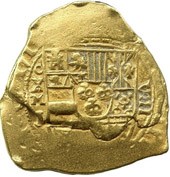 We illustrate the 1st shield die of 1711 with a rare and very curious laminate [8]. A deep fissure threatens to split obverse from reverse. Apparently two planchet of approximately 4 escudos weight were imperfectly fused and used to strike an onza. Heaven knows why. The first shield die of 1711 has distinctive left-leaning fleurs with the upper right fleur intruding beyond the Bourbon escutcheon into the field of New Burgundy. Its date is placed high in the legend with its final 1 in line with and actually touching an extension of the left border of the shield. The O in OXM J is also high and touches the same shield border. 1st shields pair with Ornate Cross die A.
We illustrate the 1st shield die of 1711 with a rare and very curious laminate [8]. A deep fissure threatens to split obverse from reverse. Apparently two planchet of approximately 4 escudos weight were imperfectly fused and used to strike an onza. Heaven knows why. The first shield die of 1711 has distinctive left-leaning fleurs with the upper right fleur intruding beyond the Bourbon escutcheon into the field of New Burgundy. Its date is placed high in the legend with its final 1 in line with and actually touching an extension of the left border of the shield. The O in OXM J is also high and touches the same shield border. 1st shields pair with Ornate Cross die A.
 A second example of the 1st shield of 1711 is pictured to the left. This one sold in an October 2012 US auction, but described as a rare 1712! The central fleurs are not visible, so that diagnostic is gone. Only the bottom of the first three date digits is visible, but the position of the 171(1) is in exactly the high position of the 1st shield. The OXM is another exact match. Notice also where the M touches the left side of the shield and the V the right side. Notice the tiny dot in the field above the O. Heavy doubling in the shield such as we see here can make die identification difficult, but if the position and shape of the date digits and OXM J are clear, and there are several small idiosyncratic die features like the dot above the O, we can sure of our dies. The reverse of this coin shows us what looks like a fairly early state of the 1711 Ornate Cross die A.
A second example of the 1st shield of 1711 is pictured to the left. This one sold in an October 2012 US auction, but described as a rare 1712! The central fleurs are not visible, so that diagnostic is gone. Only the bottom of the first three date digits is visible, but the position of the 171(1) is in exactly the high position of the 1st shield. The OXM is another exact match. Notice also where the M touches the left side of the shield and the V the right side. Notice the tiny dot in the field above the O. Heavy doubling in the shield such as we see here can make die identification difficult, but if the position and shape of the date digits and OXM J are clear, and there are several small idiosyncratic die features like the dot above the O, we can sure of our dies. The reverse of this coin shows us what looks like a fairly early state of the 1711 Ornate Cross die A.
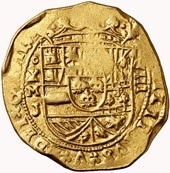 We illustrate the 2nd shield of 1711 with (one of) the best struck and highest grade examples of a 1711 onza. The Gold Cob Co. sold this coin in 2010 and Aureo resold it in 2013. Diagnostics include well positioned fleurs that do not lean left, a date positioned much lower than the 1st shield, a O centered above the X and not touching the shield, and an X centered laterally opposite the lower lion. The reverse of this onza shows us Ornate Cross die B.
We illustrate the 2nd shield of 1711 with (one of) the best struck and highest grade examples of a 1711 onza. The Gold Cob Co. sold this coin in 2010 and Aureo resold it in 2013. Diagnostics include well positioned fleurs that do not lean left, a date positioned much lower than the 1st shield, a O centered above the X and not touching the shield, and an X centered laterally opposite the lower lion. The reverse of this onza shows us Ornate Cross die B.
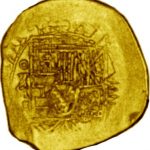 The 3rd shield for 1711 remains attested by two coins, one poorly photographed 30 years ago and another that remains in jewelry. Ponterio sold the former coin in June of 1984. The shield is too doubled to permit any diagnostics there. About 2/3 of the last three date digits are clear, and they are clearly different from the digits on the 1st or 2ndshield dies. Likewise, the position of OXM is different. The reverse of this onza may be the Cross die A for 1711, but that is not certain. [9]
The 3rd shield for 1711 remains attested by two coins, one poorly photographed 30 years ago and another that remains in jewelry. Ponterio sold the former coin in June of 1984. The shield is too doubled to permit any diagnostics there. About 2/3 of the last three date digits are clear, and they are clearly different from the digits on the 1st or 2ndshield dies. Likewise, the position of OXM is different. The reverse of this onza may be the Cross die A for 1711, but that is not certain. [9]
There is a 4th shield die used in 1711. It is the only known shield die for 1711 galanos, including the seven 1711 galanos found in 2015, but it is also used to strike the business strike shown below. This was the only known 1711 business strike from the galano shield die when it surfaced in an October 2010 Treasure Auction. Since then, in January of 2014 at the same venue, a second example came to light. Diagnostics include better fine detail on all parts of the shield, different and sharper central fleurs, and different positions for the date digits and the oXM J. 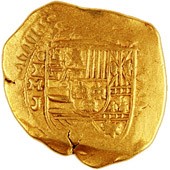 After what we’ve seen with the 1713 and 1714 onza coinage, it is no shock that the galano dies for 1711 see service with the regular 1711 coinage, but the why-did-they-do-it question remains. How many shield dies did the 1711 onza coinage require? Couldn’t the three regular dies handle it? The 1st and 2nd and 3rd shield dies show no signs of excessive use or failure in the coins we have examined. Unless there were several (unlikely) mishaps disabling the regular dies, the availability of regular dies suggests that the coiners didn’t need to use the galano dies. Was it the policy of the mint to authorize use of a soon-to-be-obsolete dated galano obverse later in the year when its special function had been served? Why not? The reverse of this coin and the same-die 2014 specimen are also important. They show a Cross Fleury, not Ornate Cross, design, proving that business strike Cross Fleury reverses were stuck in 1711. Possibly these rare coins come at the very end of 1711, when the galano dies were consigned for some reason to use with the regular coinage. In any case, there are business strikes produced with 1711 dated shield dies and Cross Fleury reverses.
After what we’ve seen with the 1713 and 1714 onza coinage, it is no shock that the galano dies for 1711 see service with the regular 1711 coinage, but the why-did-they-do-it question remains. How many shield dies did the 1711 onza coinage require? Couldn’t the three regular dies handle it? The 1st and 2nd and 3rd shield dies show no signs of excessive use or failure in the coins we have examined. Unless there were several (unlikely) mishaps disabling the regular dies, the availability of regular dies suggests that the coiners didn’t need to use the galano dies. Was it the policy of the mint to authorize use of a soon-to-be-obsolete dated galano obverse later in the year when its special function had been served? Why not? The reverse of this coin and the same-die 2014 specimen are also important. They show a Cross Fleury, not Ornate Cross, design, proving that business strike Cross Fleury reverses were stuck in 1711. Possibly these rare coins come at the very end of 1711, when the galano dies were consigned for some reason to use with the regular coinage. In any case, there are business strikes produced with 1711 dated shield dies and Cross Fleury reverses.
 7. We have said that two Ornate Cross dies were used with the datable 1711 coinage. Cross die A for 1711 has already been pictured in section 3 above, but here is another example, the reverse of the laminate we discussed above. Notice that the bottom half of the coin is afflicted with serious doubling, a very common occurrence on the 1711-12 issues. Die identification of the Ornate Cross reverses is dangerously dependent on having an undistorted presentation of the tressures and fleurs, something we often don’t get. This coin gives us enough legend (…M+RE…) to properly orient the coin. We know that the fleur with blue-gray coral belongs in the upper left quadrant. This allows us to match it with the ornate reverse shown in section 3 above. That coin in section 3 shows enough legend in its lower right quadrant to allow us to orient it. Many Ornate Cross reverses, unfortunately, show no legend. That, plus doubling and obvious striking distortions, make die matching very problematic.
7. We have said that two Ornate Cross dies were used with the datable 1711 coinage. Cross die A for 1711 has already been pictured in section 3 above, but here is another example, the reverse of the laminate we discussed above. Notice that the bottom half of the coin is afflicted with serious doubling, a very common occurrence on the 1711-12 issues. Die identification of the Ornate Cross reverses is dangerously dependent on having an undistorted presentation of the tressures and fleurs, something we often don’t get. This coin gives us enough legend (…M+RE…) to properly orient the coin. We know that the fleur with blue-gray coral belongs in the upper left quadrant. This allows us to match it with the ornate reverse shown in section 3 above. That coin in section 3 shows enough legend in its lower right quadrant to allow us to orient it. Many Ornate Cross reverses, unfortunately, show no legend. That, plus doubling and obvious striking distortions, make die matching very problematic.
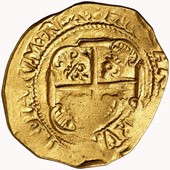 The sole clear example of the Ornate Cross B die of 1711 is shown to the left. It is the reverse of the exceptional Gold Cobs-Aureo coin discussed above. Fortunately, it has enough legend to permit us to orient it correctly. Its tressure in quadrants 1, 2, 3 are clearly different from those of cross die A. So too the position and shape of its fleurs. Notice how close the bulging large tressures in the upper right and lower left quadrants.
The sole clear example of the Ornate Cross B die of 1711 is shown to the left. It is the reverse of the exceptional Gold Cobs-Aureo coin discussed above. Fortunately, it has enough legend to permit us to orient it correctly. Its tressure in quadrants 1, 2, 3 are clearly different from those of cross die A. So too the position and shape of its fleurs. Notice how close the bulging large tressures in the upper right and lower left quadrants.
 A third cross pairs with a dated 1711 shield. That shield is the 4th or galano shield of 1711 (pictured in section 4 above). It is obviously not an Ornate Cross. Pictured to the left is the Cross Fleury reverse that pairs with the 1711 galano shield. The cross fleury and tressures are well engraved, but not quite to the quality of the 1711 galano die. As far as we can tell, this reverse die does not occur on any other surviving 1711 or 1712 issues.
A third cross pairs with a dated 1711 shield. That shield is the 4th or galano shield of 1711 (pictured in section 4 above). It is obviously not an Ornate Cross. Pictured to the left is the Cross Fleury reverse that pairs with the 1711 galano shield. The cross fleury and tressures are well engraved, but not quite to the quality of the 1711 galano die. As far as we can tell, this reverse die does not occur on any other surviving 1711 or 1712 issues.
 8. The Ornate Cross design continued into 1712. At present this is guaranteed by only one dated onza, recovered in the 1960’s by Real 8 and offered at lot 126 in the Schulman Spanish Galleon Treasure sale of November 1972. About a half dozen clearly dated 1712 media onzas second this 1712 Ornate Cross mintage. Though only the bottom of the last two date digits are present on this coin, there can be no doubt the date is (17)12. This is not the same die as the galanos of 1712, but close in workmanship. No other dated business strike 1712 onzas are known besides this coin! One of the other undated Ornate Cross onza in the Schulman sale (lot 124) seems to die match this coin, but that only bring the population of dated or die-linked 1712 onzas up to two!
8. The Ornate Cross design continued into 1712. At present this is guaranteed by only one dated onza, recovered in the 1960’s by Real 8 and offered at lot 126 in the Schulman Spanish Galleon Treasure sale of November 1972. About a half dozen clearly dated 1712 media onzas second this 1712 Ornate Cross mintage. Though only the bottom of the last two date digits are present on this coin, there can be no doubt the date is (17)12. This is not the same die as the galanos of 1712, but close in workmanship. No other dated business strike 1712 onzas are known besides this coin! One of the other undated Ornate Cross onza in the Schulman sale (lot 124) seems to die match this coin, but that only bring the population of dated or die-linked 1712 onzas up to two!
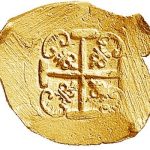 The Ornate Cross die of the Schulman coin, which looks unworn, does not match Cross dies A or B of 1711. It does not pair with a 1711 shield on any onzas we have encountered. We think this reverse may be a holdover from 1711 or it could be a new die for 1712. We are poorly informed about the 1712 mintage at this point.
The Ornate Cross die of the Schulman coin, which looks unworn, does not match Cross dies A or B of 1711. It does not pair with a 1711 shield on any onzas we have encountered. We think this reverse may be a holdover from 1711 or it could be a new die for 1712. We are poorly informed about the 1712 mintage at this point.
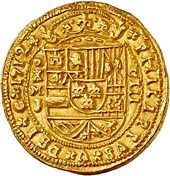 9. A second shield die dated 1712 exists. It is the galano obverse for 1712. Its reverse is a Cross Fleury die, but not the same die as the Cross Fleury galano reverses for 1711 or 1713. No 1712 business strikes are known from either of these 1712 galano dies. Our study of the 1713 Cross Fleury coinage also found no sign of the use of the 1712 galano reverse with business strikes in 1713. As far as was known until July of 2015, this 1712 galano was a unique survivor [10]. It is not a 1715 Fleet coin, surfacing in a Wayte Raymond catalogue in 1936. Pradeau saw it there and published it, without commenting on its novel cross design [11]. It surfaced again in a Calico sale in April of 2009, where it realized 247,500 euros. Now it has two attractive Fleet companions (from the same dies).
9. A second shield die dated 1712 exists. It is the galano obverse for 1712. Its reverse is a Cross Fleury die, but not the same die as the Cross Fleury galano reverses for 1711 or 1713. No 1712 business strikes are known from either of these 1712 galano dies. Our study of the 1713 Cross Fleury coinage also found no sign of the use of the 1712 galano reverse with business strikes in 1713. As far as was known until July of 2015, this 1712 galano was a unique survivor [10]. It is not a 1715 Fleet coin, surfacing in a Wayte Raymond catalogue in 1936. Pradeau saw it there and published it, without commenting on its novel cross design [11]. It surfaced again in a Calico sale in April of 2009, where it realized 247,500 euros. Now it has two attractive Fleet companions (from the same dies).
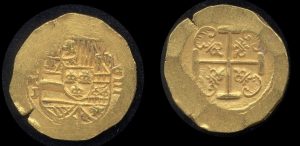 10. Two undated shield dies of 1711-12 are worthy of special attention. Shields of 1711-12, remember, show the triangle of Granada above and to the left of the central Bourbon escutcheon. By 1713 this triangle is gone. Both onzas are from the Florida State Collection. Florida State coin 11.01663 shows us a shield die we cannot match with a dated 1711 or 1712 shield. The positions of XM J and VIII are different, and the fleurs look more like the circa 1702 issues. Notice also the two short vertical bars between Sicily and New Burgundy. The Ornate Cross reverse presents us with a tough call, but it is very close to the (badly) doubled Cross Die A for 1711 shown above. If it matches, we may have found a 5th shield for 1711, though Cross Die A could have continued into 1712 with a new obverse. The cross die on this coin looks definitely more worn. Notice the die deterioration around the lower left fleur.
10. Two undated shield dies of 1711-12 are worthy of special attention. Shields of 1711-12, remember, show the triangle of Granada above and to the left of the central Bourbon escutcheon. By 1713 this triangle is gone. Both onzas are from the Florida State Collection. Florida State coin 11.01663 shows us a shield die we cannot match with a dated 1711 or 1712 shield. The positions of XM J and VIII are different, and the fleurs look more like the circa 1702 issues. Notice also the two short vertical bars between Sicily and New Burgundy. The Ornate Cross reverse presents us with a tough call, but it is very close to the (badly) doubled Cross Die A for 1711 shown above. If it matches, we may have found a 5th shield for 1711, though Cross Die A could have continued into 1712 with a new obverse. The cross die on this coin looks definitely more worn. Notice the die deterioration around the lower left fleur.
 Florida State coin 11.00022 shows us another shield die we cannot match with a dated 1711 or 1712 obverse, though the obverse is somewhat close to the 2nd Shield for 1711. The reverse, however, does match a Cross Fleury issue of 1713, possibly suggesting it was first used with 1712 issues. In fact, it is a galano reverse die for 1713! Yes, a die used to strike business strikes in 1712 is re-used in 1713 to strike galanos. A second example of this shield and cross may be at lot 161 in the Schulman sale of 1972. This coin and Schulman 161 may show us a missing set of 1712 dies.
Florida State coin 11.00022 shows us another shield die we cannot match with a dated 1711 or 1712 obverse, though the obverse is somewhat close to the 2nd Shield for 1711. The reverse, however, does match a Cross Fleury issue of 1713, possibly suggesting it was first used with 1712 issues. In fact, it is a galano reverse die for 1713! Yes, a die used to strike business strikes in 1712 is re-used in 1713 to strike galanos. A second example of this shield and cross may be at lot 161 in the Schulman sale of 1972. This coin and Schulman 161 may show us a missing set of 1712 dies.
11. To summarize our die findings:
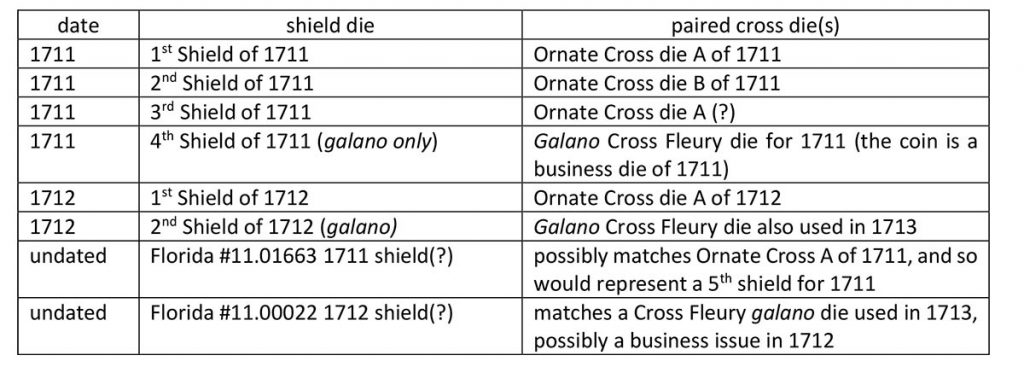
One of the big surprise is that no coin attests the use of a Cross Fleury die to strike the regular onza coinage in 1712. The one dated 1712 business strike we have pairs with a newish Ornate Cross die. It used to be thought that much (or even most) of the 1712 onza coinage was struck with Cross Fleury reverses, but the surviving coinage does not support this assumption at all. Two 1711 onzas with a Cross Fleury reverse (pairing with the 1711 galano obverse) testify that Cross Fleury business strikes were produced in 1711. All the business strikes in 1713 were struck with Cross Fleury reverses. It would be peculiar if the Cross Fleury design were retired in the interim except for the 1712 galanos. Yet the very few 1712 onzas that survive do not confirm Cross Fleury business strikes in 1712. Ignoring the galanos of 1711 and 1712, we have only two coins that represent Cross Fleury business strikes before 1713. Their rarity has been masked the abundance of 1713 Cross Fleury onzas. Our survey found only 12 securely datable Ornate Cross business issues from 1711-12.
12. The surviving population of 1711 onzas is considerably larger than 1712 onzas. In fact, we have exactly two onzas we can securely attribute to 1712. Given that these populations are almost all from the same source (1715 Fleet), this wants explaining, especially since the 1712 mintage is the later mintage. We have not yet found mint records of the 1710-13 gold coinages in AGNM (Mexico City) or AGI (Spain) though this information should be forthcoming. We expect the 1712 onza mintage will prove to be considerably smaller than 1711 or 1713. But in the meantime, there are some export facts that may bear on the differential survival of the 1711 and 1712 issues. A good portion of the 1712 gold mintage likely sailed with General Don Pedro de Ribera from Veracruz in January of 1713, leaving little from 1712 for Ubilla’s fleet 28 months later. A single Mexican galleon under General Don Andres de Arriola did sail in 1711 with more than 1.1 million pesos in manifested treasure, but it left Veracruz on January 29th, guaranteeing that not much or likely none of the 1711 gold mintage went with it to Spain [12]. Ribera’s Fleet 24 months later would likely have carried some 1711 onzas, but in the interim much of the 1711 mintage could have passed into commerce in Nueva España and later found its way onto Ubilla’s 1715 Fleet (which departed Vera Cruz on May 6). Unlike the mint state 1713 onzas recovered from the Fleet, all of 1711-12 issues show some degree of circulation.
The suggestion is that the 1715 Fleet had a somewhat better chance of carrying 1711 onzas, given the timing of Arriola’s galleon and Ribera’s fleet. Beyond this, not knowing mintages, we have nothing to suggest about the excessive rarity of 1712 onzas. If, hypothetically, some of the regular 1712 mintage did use Cross Fleury dies, and Ribera then took much of this mintage to Spain, while most of 1711 coinage used Ornate Cross dies and this coinage remained in New Spain, then we should expect a much better survival of 1711 Ornate Cross onzas, which is exactly what we see in the 1715 Fleet coinage. With the only source for pre-1713 Cross Fleury coins being the 1715 Fleet, it is not that surprising that we are very much in doubt about the 1712 coinage.
13. In the first two years of Altamira’s tenure as chief tallador, Mexico struck its gold coinage with two very different cross designs—an unprecedented event. On the evidence of the Fleet coinage, the Ornate Cross design dominated the 1711 onza mintage and may have done the same for 1712. The Cross Fleury design is attested for galanos in both years and for a single business strikes in 1711. We believe Cross Fleury dies may have struck business strikes in 1712, but no coin yet guarantees this. In 1713 the gold coinage is struck only with Cross Fleury dies. Interestingly, the Cross Fleury design was abandoned at the end of 1713 when the Duke of Altamira appointed yet another working tallador, the Ensign (Alferez) Hipolito de Sarmiento [13]. From a study of the designs we suggest that the two designs of 1711 were created by two talladores with very different artistic visions. It would be remarkable if the Mexico mint deliberately encouraged and then executed alternative designs for its gold coinage, yet it is quite possible that the Cross Fleury design was initially prepared in 1711 only for galanos. It is also possible that the Mexico City mint did not consider the difference between the designs as striking or important as we do and used dies of both designs interchangeably as needed. By the end of the 1712 coinage, the Ornate Cross tallador was apparently no longer available. By the end 1713, the horribly engraved Cross Fleury dies of that year were discarded in favor of the new designs of yet another new tallador.
End Notes
[1a] AGNM. Inst Col. “Casa de Moneda” Vol. 6. Located by Jorge Proctor.
[1] Our topic is the onza coinage of 1711-12, but we can confirm that no Box-End Crosses are known on the one, two and four escudos of 1711-12, further confirming a sharp, deliberate discontinuation of that design for all denominations. One escudos of 1711 show both of the new designs, while dated 1712 one escudos show only Cross Fleury reverses. No two escudos of 1711 are known to us. A single 1712 two escudos shows a Cross Fleury reverse. Surviving four escudos of 1711 and 1712 show only Ornate Cross reverses. No Mexican four escudos displays a Cross Fleury reverse before 1713. It is quite possible of course that both Ornate Cross and Cross Fleury reverses were struck for each of these denominations in 1711 and 1712, but by virtue of their very small mintages none have survived.
[2] Cespedes (1997) has recently published what he apparently believes to be accurate gold mintages for Mexico City. For the years 1682-1730, almost 50 years, we are asked to believe that Mexico City struck a constant 158,440 pesos in gold. Cespedes is parroting the mintages Pradeau published in 1938 and 1950. Pradeau took his mintage numbers from a 1858 study of the Mexican coinage, where the constant 158,440 pesos per year is offered as a rough guesstimate (based on some remarks by Elhuyar in 1814). Pradeau fails to mention his mintage numbers are borrowed guesstimates. For the evidence that Ornate Cross coins predominate in 1711, see section 2 and 3 below.
[3] The only securely datable 1712 onzas, two coins, are struck with Ornate Crosses. See below.
[4] Lopez-Chavez’s onza book (1961) is first in this series.
[5] This is the 1711 galano that Heritage auctioned in January of 2014 for slightly less than $294,000. It was described as “probably 1715 Fleet”, although nothing of its provenance was documented. No Real 8 records we have access to mentions it, and state records show it never came to Division with the State of Florida, so it would have been a “beach find”. It is amazing how buoyant galanos apparently are, most managing to swim/float to the beach and thereby avoid Division with the State of Florida. In fact, this 1711 is NOT a Fleet coin. It is pictured in Lopez-Chavez (1961) on page 76. Medina (1919) on page 78 mentions seeing a 1711 Mexican onza, presumably a galano, since he is talking about a 1714 Mexican galano in Vidal Quadras. We think it is probably the same coin. 1711 Royal onzas from the Fleet may exist–media onzas 1711 galanos from the Fleet certainly do–but we have never seen one.
[6] See the discussion of the 4th Shield die for 1711 below.
[7] The twelve dated Ornate Cross are published in these sources: Tauler, Escudos Macuquinos (5), Schulman 1973 (3), Sotheby’s TSM 1973 (1), Parke Bernet TSM 1967 (1), and the Florida State Collection (2). Bowers & Ruddy 1977 had no Ornate Cross onzas. Tauler duplicates the images found in Calico (2004).
[8] The Gold Cobs Co. did an unpublished study of this unique coin in 2010. The coin is accompanied by an early (circa 1966) Mel Fisher certificate testifying to its 1715 Fleet provenance.
[9] A second example of the 3rd Shield for 1711 may be at lot 18 of Sotheby’s TSM 1973, but the poor photography makes this very uncertain.
[10] Two 1712 eight escudos galanos were found on Corrigan’s Beach on the 300th anniversary of the loss of the 1715 Fleet. Medina (1919) does not know the 1712 galano exists, though he does know of the 1714 and 1711 galanos catalogued in volume III of Vidal Quadras. See Medina p.78. Lopez-Chavez (1961) mentions but does not picture a unique 1712 Royal.
[11] Pradeau (1938) p.52 and Plate IV.1.
[12] The information about Arriola’s ship and Ribera’s fleet is from Jorge Proctor’s unpublished “Caudales y Flotas 1700-1715” (2014).
[13] AGNM. Inst. Col., Gov Verreinal, General de Parte. Vol 23. Located by Jorge Proctor.
Photo Credits
Section 1: Wikipedia, common domain image.
Sections 2-9: all images courtesy of Rafael Tauler, Escudos Macuquinos Imperio Espanol , online here http://onzasmacuquinas.com/
Section 10: both images courtesy of the Florida State Collection, Bureau of Archaeological Research (BAR), Tallahassee.
References
Bowers & Ruddy Galleries. The Harold A Blauvelt,…& 1715 Spanish Treasure Fleet Auction. Los Angeles, February 17-19, 1977.
Calico, X. LA ONZA. Barcelona, 2004
Cespedes del Castillo, Guillermo LAS CASAS DE MONEDA EN LOS REINOS DE INDIAS. Vol 1. LAS CECAS INDIANAS EN 1536-1825. Madrid, 1997.
Craig, Alan SPANISH COLONIAL GOLD COINS IN THE FLORIDA COLLECTION Gainsville, 2000.
Flemming, Philip THE GOLD COBS OF MEXICO 1697-1732. Privately printed. Scottsdale, 2013.
“Varieties of the 1714 Mexico City Eight Escudos” Journal of the US Mexican Numismatic Assoc. Carefree, AZ., June 2014
Lazo Garcia, Carlos ECONOMIA COLONIAL Y REGIMEN MONETARIO PERU: SIGLOS XVI-XIX. Lima, 1992
Lopez-Chavez y Sanchez, Leopoldo CATALOGO DE LA ONZA ESPANOLA. Madrid, 1961
Medina, Jose Toribio LAS MONEDAS COLONIALES HISPANO-AMERICANAS. Chile, 1919
Parke Bernet Galleries TREASURES OF THE SPANISH MAIN. New York, February, 1967
Pradeau, Alberto NUMISMATIC HISTORY OF MEXICO. Los Angeles, 1938.
Proctor, Jorge “Caudales y Flotas 1700-1715”, unpublished research paper, 2014.
Schulman, Hans SPANISH GALLEON TREASURE. Schulman Coin & Mint. New York, November 27-29, 1972
Sotheby’s Parke Bernet TREASURES OF THE SPANISH MAIN. Los Angeles, June, 1973.
Vidal Quadras y Ramon, M. Catalogo de la Coleccion de Monedas y Medallas de Manuel Vidal Quadras y
Ramon de Barcelona. 4 volumes. Barcelona, 1892.
